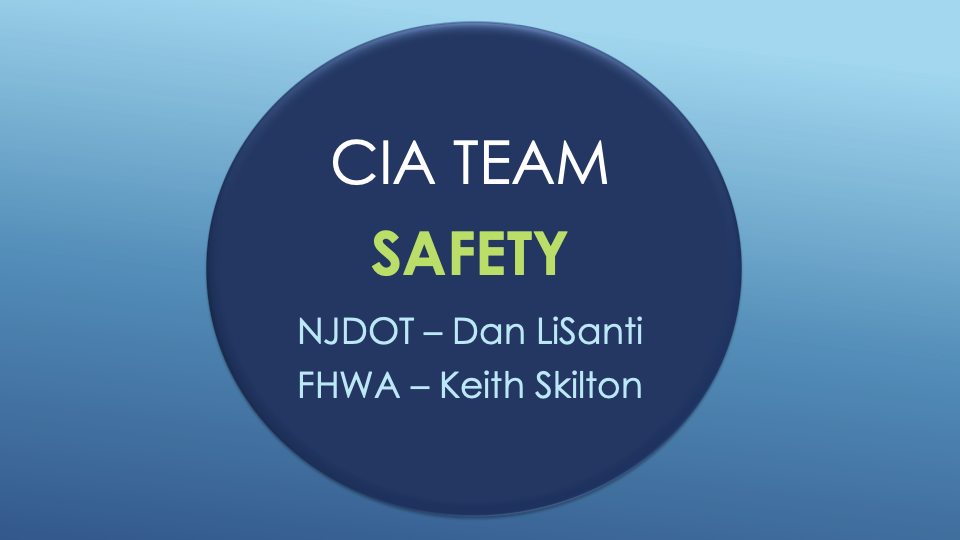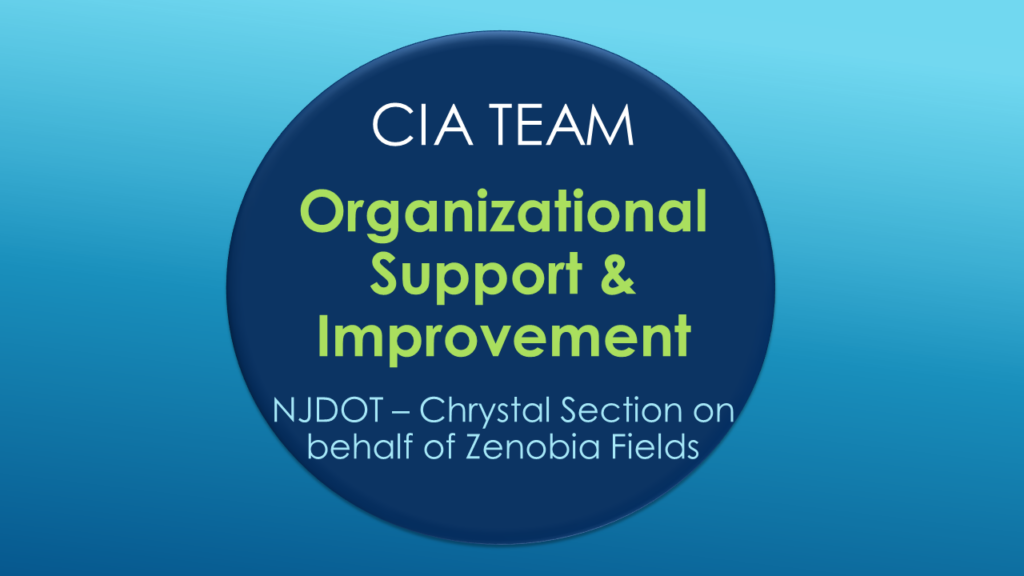The NJ State Transportation Innovation Council (NJ STIC) convened virtually for the 3rd Quarter Meeting on September 19, 2022. The NJ STIC Agenda had been distributed to the invitees prior to the meeting. Participants could use the Microsoft Teams platform chat feature to offer comments or ask questions of the speakers during the online meeting.
Brandee Chapman, NJDOT Innovation Coordinator greeted the meeting participants, followed by Assistant Commissioner Michael Russo who provided the Welcome and Opening Remarks.
FHWA EDC Innovation. Helene Roberts, Innovation Coordinator and Performance Manager for the FHWA NJ Office, noted that there are three months remaining in EDC-6 and the EDC-7 cycle will begin in January 2023. She does not have information about the initiatives that will be part of the next cycle, but they should be announced soon. The EDC-7 Summit will likely be held in early December as a virtual event, featuring some states that have used the initiatives successfully, and will be followed by a NJ Caucus, where the NJ STIC will discuss the opportunities and barriers of the new initiatives and consider what initiatives New Jersey should pursue. The final reports for EDC-6 will be completed in January 2023.
Core Innovation Area (CIA) Updates. The meeting continued with presentations from Core Innovative Area (CIA) leaders who provided updates of the status of EDC initiatives on the topics of Safety, Infrastructure Preservation, Mobility and Operations, and Organizational Improvement and Support.
There was a brief break during which meeting participants could take part in a transportation trivia quiz through Mentimeter.
Featured Presentation – Safety CIA Team. The featured presentation was delivered by Daniel Lisanti, Manager, and Jeevanjot Singh, Section Chief for the Bureau of Safety, Bicycle & Pedestrian Programs (BSBPP).
Mr. Lisanti noted that the Bureau comprises three units: the Office of Safety Program Management, Office of Bicycle and Pedestrian Planning, and the Office of Complete Streets Implementation. The Bureau manages the federally-funded Highway Safety Improvement Program (HSIP) for all roads in the State, manages the implementation of the 2020 New Jersey Strategic Highway Safety Plan (SHSP) for Bicycle and Pedestrian Planning, and serves as the Subject Matter Expert (SME) on Complete Streets Implementation. The Bureau also manages technical projects that identify, inventory, review and analyze safety concerns along state and non-state roads, and suggest safety countermeasures, among other responsibilities.
Currently, the Bureau has 214 active HSIP projects in various stages of development. Mr. Lisanti gave an overview of the Bureau and the evolution of the programs over the past decade, explaining that HSIP funding increased and NJDOT shifted from funding low-cost, quick-fix maintenance projects to supporting larger scale capital improvement projects.
Mr. Lisanti reviewed the Bureau’s previous STIC-related accomplishments which include work on the Safe Transportation for Every Pedestrian (STEP) initiative for EDC-4 and EDC-5 involving an action plan for pedestrian crossing countermeasures at uncontrolled locations, and systemic safety projects for midblock crosswalk safety improvements. For EDC-3, the Bureau used STIC funding to hold local safety peer exchanges to discuss Data Driven Safety Analysis and substantive safety and the systemic safety approach. Related to the EDC-5 initiative Reducing Rural Roadway Departures, NJDOT held a three-day virtual training with FHWA and the FHWA Resource Center.
The Bureau has changed focus to consider why crashes happen, and to take steps to proactively address the risk of a crash. Projects include Horizontal Curve Safety Assessment which is nearing completion, Wrong Way Driving, and forthcoming safety assessments for School Zones and Intersections. Other areas of focus include Vegetation Safety Management and Midblock Crosswalk Improvements on NJDOT roadways.
Ms. Singh reviewed several improvements to the Safety Project Delivery Process to institutionalize safety in all of their projects. The Bureau is using condensed CD checklists in the limited scope process for the Horizontal Curve Sign Program and High Friction Surface Treatment to fast-track deployment. They have included Highway Safety Manual analysis and Complete Streets checklist activities to the Capital Project Delivery Process network diagram to ensure project managers are aware of requirements for HSIP projects. The Bureau is working with consultant selection teams for proposal reviews for HSIP projects to determine the best consultant team. The Bureau has developed a Post Deployment Evaluation process which incorporates three and half years of data. This process has been submitted to FHWA for approval. If approved, the process will be used for assessment of Center Line Rumble Strips, High Friction Surface Treatment, and Road Diets. Ms. Singh discussed the introduction of split funding and job order contracting for Safety Project Delivery using HSIP monies. The Bureau is diversifying their project portfolio and coordinating with NJDOT Maintenance on vegetation management, with Technology on wrong way driving warning systems, pedestrian detection systems, and Lead Pedestrian Intervals, and with Communications on Public Service Announcements (PSAs) and public outreach.
As previously noted, the Bureau is responsible for SHSP implementation. Ms. Singh noted a robust process that has engaged 200 stakeholders. She provided an update on progress on the original 35 priority actions and noted that 22 action items have been added for Year 2.
Finally, Ms. Singh made note of the Safety Resource Center (SRC), a one-stop centralized clearinghouse for transportation safety in NJ. The SRC disseminates information and connects multimodal transportation experts, public officials, academia, and the public to industry resources such as safety trainings, technical standards, guidance, plans, research, case studies, best practices, and technical assistance. In the future, the SRC will be responsible for the NJDOT SHSP plans and updates.
Reminders and Updates. Ms. Chapman closed the meeting with information and reminders on the online location of several resources that highlight the NJ STIC and other innovation topics funded through research and technology transfer activities, including:
- NJDOT Tech Transfer Website: http://www.njdottechtransfer.net/
- NJ STIC Website: https://www.njdottechtransfer.net/nj-stic/
- NJ STIC Meetings: https://www.njdottechtransfer.net/nj-stic-meetings/
The NJ STIC Innovative Initiatives Survey has been distributed via email. Responses will be shared at a future STIC meeting and innovative initiatives will be featured through the NJDOT Technology Transfer program. The survey will help identify examples of implemented EDC initiatives and other innovative practices in New Jersey, and consider the challenges of implementing innovative practices. Please share the survey with your networks – the target audience is members of local public agencies, MPOs and other transportation professionals. Responses are due by September 30th. The survey can be found here.
Ms. Chapman announced the 2022 Build a Better Mousetrap Competition Winner – The Sawcut Vertical Curb. The Sawcut Vertical Curb method involves cutting a typical 4-inch curb to 2-inches to comply with updated standards for guard rail. The existing guide rail can remain in place while cutting the curb and the construction crew can remove and upgrade the guide rail later. This new method saves time, money, and improves the safety of both work crews and road users.
Ms. Gendek and Ms. Chapman submitted the Sawcut Vertical Curb as the first nomination to the annual AASHTO Innovative Initiatives competition earlier this month, and a winner will be selected by the end of the calendar year. The competition is for proven advancements in transportation technology and AASHTO is using the competition to accelerate adoption of innovations by agencies nationwide.
FHWA featured NJ STIC in the September/October issue of the Innovator publication. Using excerpts from our presentation at the National STIC meeting, the article mentions the STIC Communications Plan, piloting of the Let’s Go! Workshop, and more. You can read the full article at the link here.
Ms. Chapman reported that she attended the 2022 State Innovation Forum in San Diego, CA. The purpose of the forum was to exchange ideas with DOT Innovation peers, helping to shape the future of transportation innovation. Attendees also included AASHTO, TRB, and FHWA who were looking to gain insight into new tools and learn about the needs of the group.
The 2022 NJDOT Safety Summit will be held as a virtual event on October 11, from 10am-12pm. Go to saferoadsforallnj.com for more information.
STIC Incentive Program funds are still available for 2022 and more funds will be available soon for the coming year. The FHWA offers these funds, as well as technical assistance, to support the costs of standardizing innovative practices in a state transportation agency or other public sector STIC stakeholder. NJ STIC receives $100,000 each year. Ms. Chapman asked that the STIC network members communicate these grant opportunities through their networks. Local public agencies are eligible to apply. Find more information, including examples of allowable activities and prior recipients, here.
Amanda Gendek, Manager of the NJDOT Bureau of Research, and Mike Russo provided closing remarks.
NJ STIC September 2022 Meeting Recording









